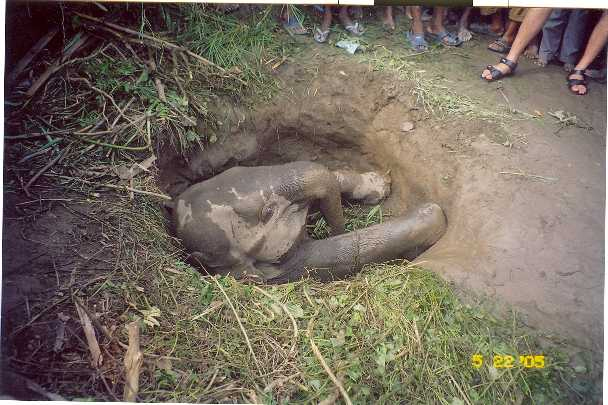-Ankur Chaturvedi
The elephants are an integral part of Indian culture. They are generally referred to asGanesh , the elephant Headed Hindu God. As per Hindu mythology, obeisance toGanesh
is obligatory before paying reverence to any other God. The elephants have been an influence on every aspect of life in India . Unfortunately however we have today created a situation where this courtly Giant has come into conflict with us.
Human Elephant Conflict or HEC is the biggest environmental challenge in the elephant habitat in India .
On a cold winter morning in early 1997 I had my first encounter with wild elephants outside a wildlife sanctuary. A small herd of about 20 elephants was crossing through the Tea Estate. It was indeed an awesome sight with the babies carefully herded in the
middle by the adults, as the herd made its way through the tea gardens. The calm of the morning was shattered by a loud bang of a firecracker followed by clamour from the Labour lines nearby. The elephants panicked and changed direction and within minutes
were herded once again as the approached another habitation. By the time I started feeling the bright morning sun; the herd had probably lost its bearings and had assembled in a shaded area within the Tea Garden. The Adults had formed a circle around the young
calves. A big Tusker stood outside the protective cordon and charged at any human movement towards them. Even though I would have loved to stay put and observe these beautiful beasts, I had to return to cater to my professional responsibilities.
At noon I managed to squeeze in a visit to my friends and immediately regretted the sight. The handsome Tusker was visibly at his wit's end. The fatigue was evident. His charge was now more of a stagger. The rest of the heard was in no better state, their
skin parched as they were bearing the brunt of the most uncivilised actions of the social animal. A crowd of over a few hundred onlookers had gathered at the sight. A constant volley of stones with an occasional firecracker was being hurled at the bewildered
herd. My protest went unheeded. I was aghast as to how people can be so cruel to this Gentle Giant.
Not very long back on the 22 nd of May 2005 , a day after my daughter's first birthday, I was planning on an extended nap well into the morning when I was informed at 6 AM that an elephant had fallen into a pit. A hideous sight greeted me. An elephant not
more that a few years old had slipped into an open well. Only his trunk and forelimbs were above the ground. He was stuck in the mouth of the well around its waist. What made this gruesome sight ghastly was that people were hammering away at this incapacitated
beast with rods and sticks. Some were even trying to jab his eyes with bamboo sticks. Thanks to the help of the committed team of volunteers from Dam Dim Tea Estate, we not only managed to ward the ominous crowd but also managed to safely rescue the trapped
elephant.

The incidents narrated above are not uncommon in the Tea Growing areas of North Bengal . I have been a witness to widespread devastation caused by the elephants. It is impossible to explain the virtues of conservation to a poor family who has just lost its
entire crop of Paddy to a maundering herd of wild elephants. I definitely do not condone the acts of cruelty against the elephants but after spending a decade studying the problem cannot affix the blame on the poor population of the area.
Human Elephant Conflict or HEC is the biggest environmental tragedy of both the Elephant and Human Population of this area. The Forests in Dooars comprising Buxa Tiger Reserve, Teesta and Torsa river areas, Baikumthapur, Kalimpong, Jalpaiguri and Coochbehar
forest divisions have an estimated Elephant Population of about 500. The vegetative degeneration in addition to innumerable human habitations inside the forests has rendered the existing habitats redundant. The elephants are forced move out of the forests
in search of food. Paddy and Maize, the major crops of the area are ideal fodder for the hungry herds. The locals use spears, arrows, firecrackers and even firearms to drive away the elephants. Invariably the Elephant gets injured and unable to bear the pain
goes berserk, causing even more damage.
( To be continued)
Update in 2018
Watch our short film on human elephant conflict at the link
https://youtu.be/Z08hNz-Puok